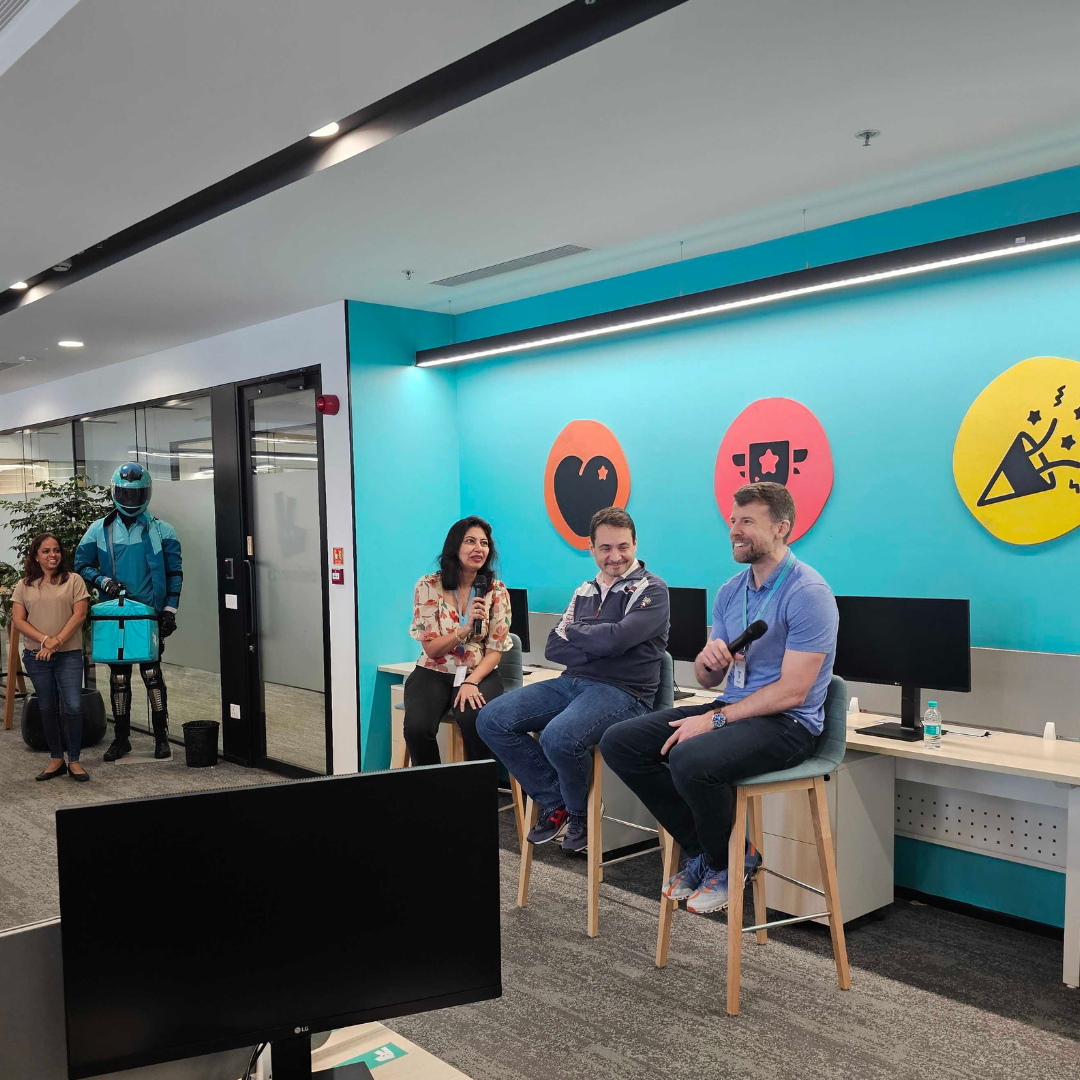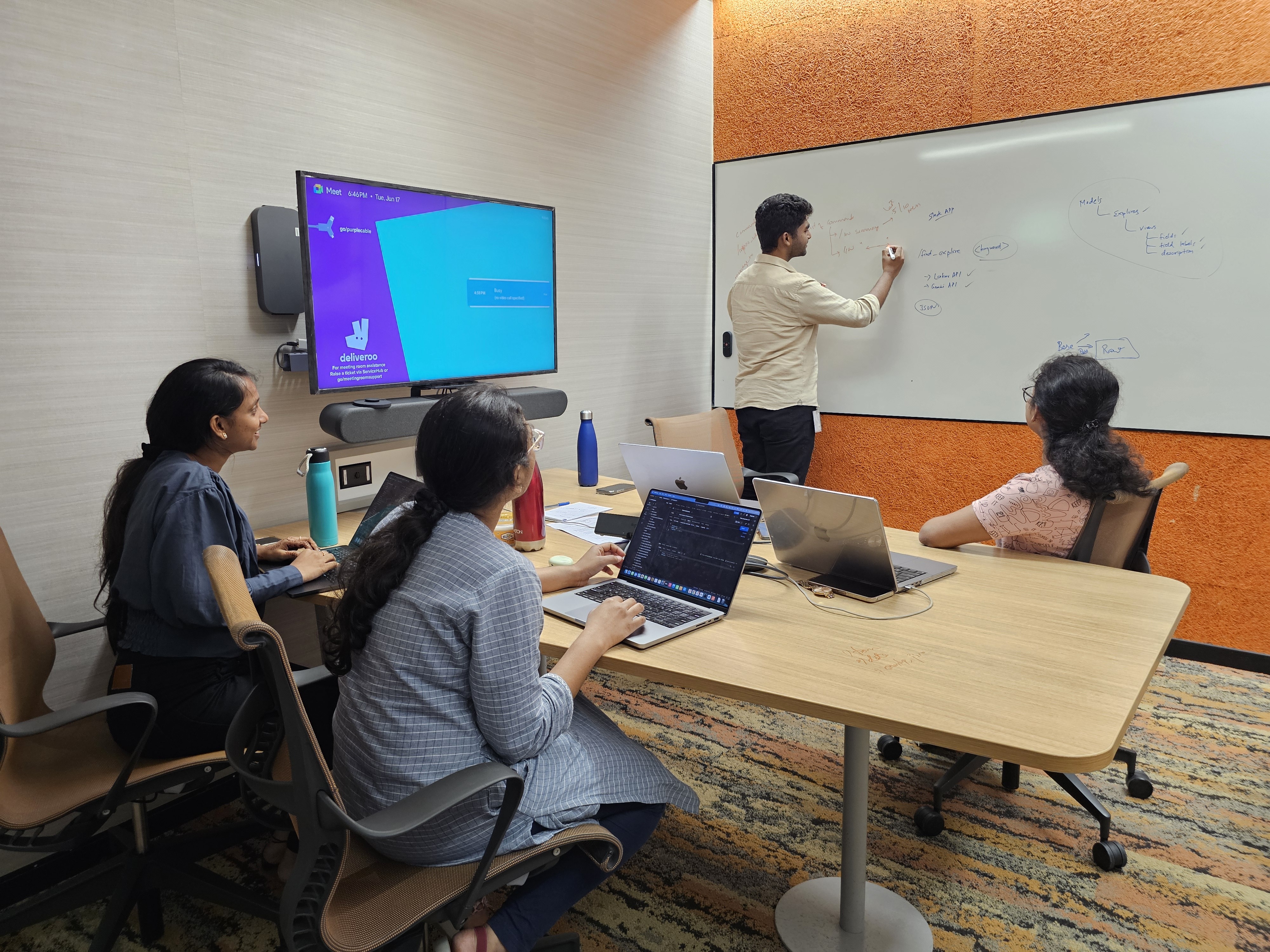Engineering at Deliveroo India: How We Build, Collaborate, and Grow
Since joining Deliveroo in 2023, Kartik has worked on products that span our entire platform - from launching a profitable advertising business to building tools for corporate orders. But the real story is how we build. At our India hub, cross-functional teams have full ownership, collaborate across time zones, and move fast without sacrificing quality. Here’s what that looks like in practice.
Hey everyone, I’m Kartik Visvanathan, an Engineering Manager at Deliveroo, based in India. I joined the team in 2023, and it’s been an exciting ride ever since. I’ve built some truly impactful products here, including an advertising platform that we scaled into a profitable business, and a corporate orders product that touched every part of our systems—from restaurants to delivery to customer service.
But while building cool stuff is awesome, what I really want to share today is the secret sauce behind it: how we work as a team here in India.
A Truly Global Hub
Our engineering hub in India is a core driver of Deliveroo’s global mission. Over the past few years, our teams have transitioned and taken complete ownership of key product areas. Whether we’re improving the restaurant onboarding flow or fine-tuning our delivery times, the work we do here is absolutely core to Deliveroo’s success. When our India Development Center (IDC) started a few years back, we had engineers reporting directly to managers in the UK. I was one of the first engineering managers hired in India in 2023, and I was given the opportunity to build a team that was entirely based here.
We’ve since grown to include other roles like product managers, analytics engineers, and data scientists right here in India. This lets us have “co-located teams”—people who can sit in the same room, grab a whiteboard, and even go out for a team social that isn’t virtual.
When candidates ask about my favorite parts of the job, I always mention three things: cross-team collaboration, work flexibility and life harmony, and a culture of ownership. So let’s dive into those.

How We Collaborate Across Teams
Working with teammates in London and other time zones means a lot of asynchronous communication. We rely heavily on tools like Slack, Confluence, and Figma, which are essentially our digital whiteboards. Regular virtual stand-ups and a focus on clear ownership help us build trust and keep things moving.
In the advertising and corporate orders spaces, many of the features my teams build touch other teams’ systems. This means we have to integrate with other Deliveroo teams to do things like show an ad on the homepage or create a special checkout experience for corporate customers. In some companies, this level of cross-team dependency can be a huge roadblock. I’ve had past experiences where getting anything done meant creating a bunch of tickets, waiting for approvals, and attending countless “office hours.”
At Deliveroo, it’s completely different. We launched our initial products in both the advertising and corporate order spaces within a single quarter - a feat that wouldn’t have been possible without our seamless cross-team collaboration.
So, how does it work?
- Our engineers start by diving into other teams’ documentation and code, posting questions in public Slack channels to get quick answers without unnecessary meetings.
- Teams proactively share their “how-to” guides, making it easy to get up to speed on their codebases.
- We write Technical Design Documents and share them for review, with engineers encouraged to pair with teammates from adjacent teams for smoother collaboration.
- Once approved, we develop and the external team reviews our code changes. The amazing thing is that no matter how busy other teams are, they always support us and we make sure to contribute high-quality code without adding maintenance burden.
Collaboration also extends to the core partnership of engineering, product, design, and science. For example, a while back, we were launching an experiment with a new display ad format with videos on our Order Tracker page. Our Product Manager worked with us to define the requirements and experiment goals, while our Product Designer created the user experience (UX) design for the new format. Our Engineers then developed the ad creation and rendering logic, and our Data Scientists designed the experiment and helped us analyze the results to see which ad layout was most engaging for customers and profitable for the business. It’s a true partnership where everyone’s expertise is valued.

A Typical Week: Lightweight Rituals and Focus time
We believe in balanced work weeks with clear priorities, lightweight rituals, and respect for focus time.
Our teams usually have a 15-minute standup each day. We follow two-week sprints and have sprint retros, planning, and demos at the end or beginning of each sprint.
When I first joined, I was impressed by how the team prioritized keeping meetings to a minimum. Leadership constantly reminds us to reduce meeting time and increase focus time. We have designated “no-meeting” slots every day, and some teams even have full “no-meeting” days, like No-Meeting Wednesdays.
Cross-border meetings are scheduled to work for everyone—no late-night calls, and evenings are for family. Everyone’s conscious about work hours; our UK Product Manager uses scheduled Slack messages so I get them at the start of my day. Outside of on-call duties, there’s a healthy work-life balance.
We also have a flexible work schedule. While the entire team is usually available during a common window when we have our meetings, engineers can choose to start their day early or work later to fit their individual needs.
Autonomy, Ownership, and Growth
We believe that true ownership means being accountable for everything we build. This means our engineers also own the infrastructure setup, monitoring, and ongoing maintenance of their services. There’s no separate team to hand off work to—if you build it, you own it.
Engineers here lead projects end-to-end, from scoping to release. For every major project, we assign a Feature Lead Engineer. This engineer works with the product manager to understand the requirements and creates the Technical Design Document. Beyond just creating the design document, they’re empowered to build the entire work plan themselves. Engineers set realistic expectations based on their expert judgment rather than working backwards from fixed deadlines. While Engineering Managers are there to guide and review, the ultimate owner is the Feature Lead, giving them greater responsibility and accountability.
This sense of ownership applies not just to product features, but also to crucial tech initiatives and tech debt. We groom our tech backlog at least once a month to ensure there are clear stories for engineers to pick up during sprints. While managers can provide suggestions based on priorities and an engineer’s growth plan, it’s ultimately the engineer who owns their work.
When things don’t go as planned — which is a natural part of building at scale — our culture is one of support, not blame. If an unexpected risk emerges that could delay a project, we rally together to find the best path forward. This team-first mindset also extends to how we manage production incidents. Our incident management process is designed to minimize customer impact quickly while also ensuring we prevent similar issues in the future. It’s inspiring to see how rapidly and effectively teams come together in these moments — a true reflection of our customer obsession. Following an incident, we conduct a blameless, lightweight postmortem. Engineers are empowered to document and present learnings to senior engineers and managers, with the focus squarely on systems and processes, not individuals. This creates psychological safety while driving objective improvements. Finally, through our “lessons learned” forum, we make sure these insights are shared beyond a single team. By spreading knowledge across the company, we collectively learn and improve — turning challenges into opportunities for growth.
Beyond immediate team work, we have “guilds” where engineers can take ownership of technical improvements at a company level. We have guilds for Android, iOS, Web, and Go lang, among others. There’s even a GenAI guild that explores how to use AI to improve coding velocity, quality, and business use cases. For example, our engineers have access to a number of GenAI-assisted coding tools like Cursor, Windsurf, and Gemini Code Assist, which they can choose to use for development and code reviews. We’re also rapidly incorporating AI into business use cases, like building chatbots to enhance support for our customers and restaurant/grocery partners. This group has explored so many AI applications it could be its own blog post!
On top of all that, we have regular tech talks in India where engineers share their knowledge about everything from Go-lang to Kafka. This year, two of the four winning teams at our annual Hackathon were from the IDC, a testament to the incredible talent and innovation within our hub.

We have a clear levels and expectations framework that defines what is expected at each career stage. Managers hold regular 1:1s with engineers to set goals and provide feedback. With a wealth of senior talent and mentors available, engineers can truly drive their own career path. In fact, my teams have been consistently growing people, which speaks to the opportunities within the company, our supportive culture, and the high level of ownership our engineers take.
At Deliveroo, we’re building systems that “transform the way people shop and eat, bringing the neighbourhood to their doors by connecting consumers, restaurants, shops and riders.” What makes this work truly special isn’t just the global scale or the technical challenges—it’s getting to solve these problems alongside teammates who genuinely care about the craft and the impact we’re making. If you’re an engineer who thrives on ownership, values collaboration, and wants to build products that millions of people rely on, I’d love to hear from you.
Curious about engineering at Deliveroo India? We’re always looking for great people to join our team. Check out our open roles.

